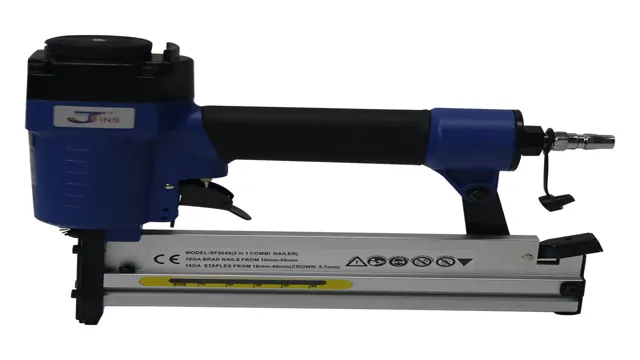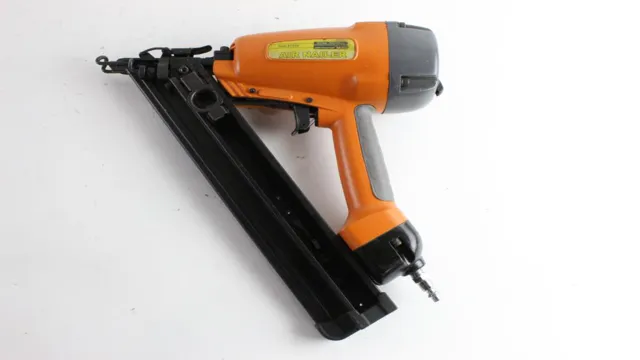What Size Air Nailer for Framing? A Complete Guide to Choosing the Right Tool

Are you planning to take on a framing project for your home or business? Then you must be considering investing in an air nailer! However, with different sizes and types available in the market, it’s understandable to feel confused. So, what size air nailer for framing should you use? The answer is not as straightforward as you might think, but we’re here to guide you through it. A good air nailer can make your work quicker and easier, letting you focus on the creative aspect of framing.
Let’s dive in to find out which air nailer size you need for a successful framing job!
Understanding Air Nailers
When it comes to framing jobs, it’s crucial to use the right size air nailer for the task at hand. A framing air nailer is a heavy-duty tool that’s designed to handle a variety of materials, including hardwoods and tough engineered lumber. The optimal size for a framing air nailer is typically 3-1/2 inches, which can drive larger nails and handle a wider variety of materials.
However, if you’re working with thinner materials, a smaller, more compact size air nailer might be able to get the job done with better accuracy. It’s important to consider the project’s requirements and materials and find an air nailer that can handle them effectively. Ultimately, choosing the right size air nailer is key to ensuring a successful framing project.
Types and Uses
If you’re in construction or woodworking, you’ve likely heard of air nailers. These handy tools use compressed air to drive nails into wood, metal, or even concrete. The types of air nailers available include brad nailers, finish nailers, framing nailers, and roofing nailers.
Brad nailers are great for delicate work such as attaching trim or baseboards, while finish nailers are useful for larger projects such as hanging cabinets or installing hardwood flooring. Framing nailers are larger and can handle heavy-duty jobs like building a house or constructing a fence. Finally, roofing nailers are specifically designed for roofing work, and can handle tougher materials such as asphalt shingles.
While some may argue that using a hammer and nails is more traditional, air nailers can save significant time and effort on a job. Just make sure to wear ear and eye protection, as the tools can be quite loud and produce flying debris.

How They Work
Air nailers are powerful tools that use compressed air to drive nails into wood or other materials quickly and efficiently. These tools work by using a small piston that compresses air when activated by a trigger. The compressed air then drives the piston forward, which pushes the nail out of the tool and into the material being worked on.
Air nailers are commonly used in construction and carpentry work because they allow for precise and consistent nailing, which saves time and reduces physical strain on the user. The best part about air nailers is that they come in a variety of sizes and are compatible with different types of nails, so users can choose the perfect tool for their needs. Overall, air nailers are a fantastic tool for any DIY enthusiast or professional tradesperson looking to improve their efficiency and productivity.
Factors to Consider
When it comes to framing, the size of the air nailer you use can greatly impact the end result. The most common sizes for air nailers used for framing are 10-gauge, 11-gauge, and 12-gauge. The size you choose ultimately depends on the size of the nails you plan on using and the type of wood you will be working with.
10-gauge nailers are great for larger, thicker pieces of wood, while 11-gauge and 12-gauge nailers are better for thinner, softer woods. Additionally, consider the weight and size of the nailer itself. You want to be able to use it comfortably and effectively, so choose a size that you can handle without too much strain.
Ultimately, the size air nailer you need depends on the project at hand, so take the time to assess your needs and make an informed decision.
Nail Size
When it comes to DIY projects that involve woodwork, choosing the right nail size is crucial for the overall success of your project. One of the main factors you need to consider is the thickness of the wood you are using. Different nail sizes are designed to work best with specific thicknesses.
For instance, using a tiny nail on a thick board will not provide the necessary stability and may even damage the wood, while using a large nail on a thin board may cause splitting. Another important aspect to consider is the type of wood you are using, as some types are harder and denser than others. For example, harder woods like oak and maple require longer and thicker nails compared to softer woods like pine and cedar.
By considering these factors and choosing the right nail size, you can ensure that your project is both sturdy and aesthetically pleasing.
Gauge
When it comes to selecting the right gauge for your project, there are several factors to consider. The first is the material being measured. Different gauges are designed for use with specific materials, such as plastic, metal, or wire.
It’s important to choose a gauge that is suitable for the material being measured to ensure accuracy and reliability. The second factor to consider is the size of the material being measured. For example, a large piece of metal will require a different gauge than a small piece of wire.
Other factors to consider include the accuracy needed, the frequency of measurements, and the environment in which the gauge will be used. By taking all of these factors into account, you can select the right gauge for the job and ensure accurate and reliable measurements.
Air Pressure
Air pressure is an important concept to understand, as it can have a significant impact on our daily lives. One of the main factors to consider when it comes to air pressure is altitude. As we climb higher into the atmosphere, the air becomes less dense, which means that there is less pressure pushing down on us.
This can lead to a variety of physiological effects, such as shortness of breath and fatigue. Another important factor to consider is temperature. As the temperature of the air changes, so does its pressure.
Warmer air is less dense than cooler air, which means that it exerts less pressure. This is why, in hot weather, we may sometimes feel like the air is “thinner” or less substantial. Additionally, the presence of weather systems, such as high and low pressure systems, can also have a profound impact on air pressure.
Understanding these various factors can be important for a variety of reasons, including aviation, weather forecasting, and even everyday activities such as hiking or outdoor sports.
Magazine Capacity
When it comes to choosing a firearm, selecting the right magazine capacity is a crucial factor to consider. The magazine capacity refers to the number of rounds a firearm can hold in its magazine without needing to be reloaded. The right magazine capacity will depend on various factors that include personal preference, intended use, and local laws and regulations.
For instance, if you plan to use your firearm for self-defense, you may want a higher magazine capacity that allows you to take multiple shots in quick succession. However, some states have magazine capacity restrictions, so it’s important to research and comply with local laws. Additionally, guns with higher magazine capacities can be heavier, bulkier, and more challenging to conceal, so finding a balance between capacity and convenience is key.
Ultimately, it’s crucial to choose a magazine capacity that works best for you and your intended use of the firearm.
Recommended Size for Framing
If you’re planning to start a DIY framing project, you might want to know what size air nailer you’ll need. The most common size for framing is a 3 1/2 inch nail gun, but you might see other sizes like 2, 2 1/2, and 3-inch nailers. However, the size of your nail gun will depend on the size of the framing material you are working with.
For larger and thicker woods, you’ll need a longer nail because it will ensure that the joint is secure. On the other hand, if you’re working with thinner materials, a shorter nail can do the job efficiently. It’s essential to consider the type of project you’re undertaking before deciding what size air nailer to use.
Regardless of the specific size you choose, it’s crucial to observe safety guidelines and wear the right gear while working with nail guns.
Gauges and Nail Sizes Compared
When it comes to framing, the recommended size of nails and gauges can vary depending on the type of wood being used and the weight of the object being hung. For light framing, a 16-gauge nail that is 2 to 5 inches in length is suitable, while for heavier framing, a 12-gauge nail that is around 3 inches in length is ideal.
It’s important to choose a nail size and gauge that can withstand the weight of the object without bending or breaking. Using nails that are too small or too large can compromise the structural integrity of the frame and lead to damage or collapse. Ultimately, it’s best to consult with a professional or refer to a framing guide to determine the appropriate nail size and gauge for your specific project.
Remember, taking the time to choose the right size and gauge will ensure the longevity and durability of your framed object.
Common Size for Framing
When it comes to framing your favorite artwork or photographs, it’s important to choose the right size to showcase them in the best possible way. There are certain common sizes that are recommended by experts in the industry. For instance, 8×10 and 11×14 are common sizes for smaller pictures.
If you have a larger piece, 16×20 or 18×24 are great options. Ultimately, the size will depend on your personal preference and the style and size of the artwork. Just ensure that you leave enough space between the edge of the picture and the frame, so as not to cover any important details.
Choosing the right size will make all the difference in how your piece is displayed and appreciated. So, take your time, consider your options, and choose the perfect size for your treasured artwork or photograph.
Conclusion
When it comes to choosing the right size air nailer for framing, you don’t want to go too big or too small. It’s all about finding the sweet spot that will give you the power, speed, and precision you need without breaking the bank or weighing you down. So, think of it like finding the perfect pair of shoes.
You want something sturdy, comfortable, and just the right fit. And remember, no matter what size you choose, the most important thing is always safety first!”
FAQs
1. What are the types of air nailers suitable for framing? A: The types of air nailers suitable for framing are 21-degree and 28-degree framing nailers, which can handle nails of up to 3-1/2 inches long. 2. What air pressure is required for a framing nailer? A: Typically, a framing nailer requires an air pressure between 70 and 120 PSI to function effectively. 3. Can I use a finish nailer for framing? A: No, a finish nailer is not suitable for framing as it only handles nails of up to 2-1/2 inches long, which are too short for framing applications. 4. What is the difference between a clipped head and a round head framing nailer? A: A clipped head framing nailer holds more nails in its magazine and can fire them quickly, while a round head framing nailer is safer due to its full head design, which provides more holding power. 5. Can I use a cordless framing nailer for a large framing project? A: It depends on the capacity of the battery and the depth of the nails required. A cordless framing nailer may not have enough power to handle a large framing project. 6. Can I use an air nailer for other applications besides framing? A: Yes, air nailers can be used for a variety of applications, including roofing, siding, finishing, and trim work, among others. 7. How do I maintain my air nailer for optimal performance? A: Regular cleaning and lubrication of moving parts, proper storage, and using the right nails for the nailer are essential to maintain optimal performance of an air nailer.




